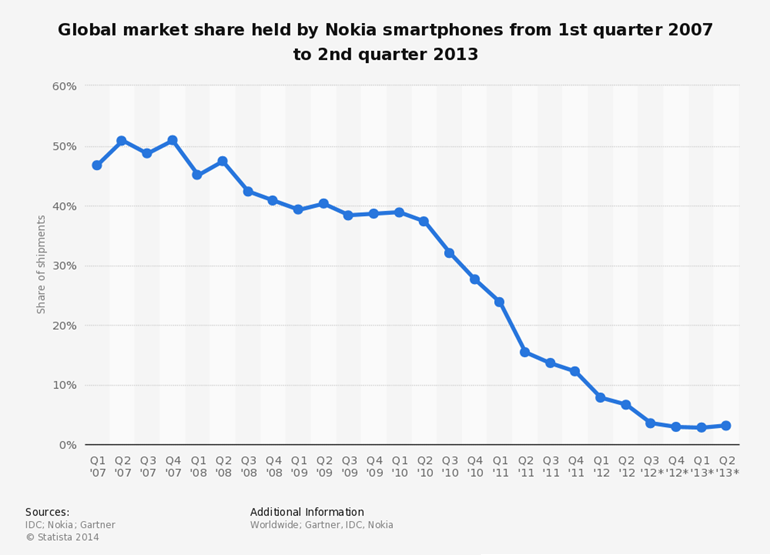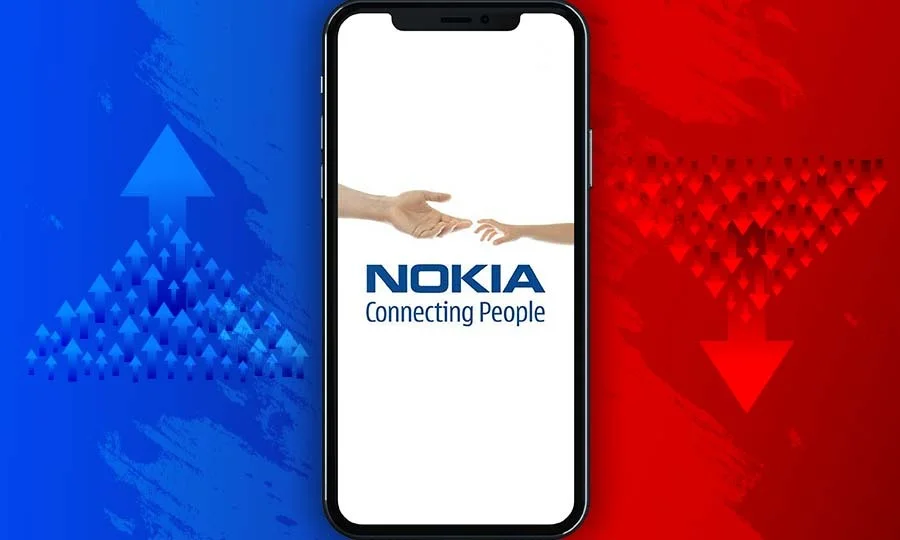During the early 2000s, Nokia reigned supreme in the mobile phone market, boasting a significant global market share. Back then, Nokia faced little competition as it offered highly acclaimed and popular products like the Nokia 1280, Nokia 5300, Nokia N91, and Nokia N95. However, the brand’s fortunes took a nosedive as it witnessed a gradual decline in market share, eventually ceding ground to rivals such as Apple and Samsung. In 2014, acknowledging its inability to sustain a presence in the mobile phone market, Nokia made the decision to sell its mobile phone business to Microsoft. What led to the downfall of this once mighty mobile industry leader in a mere span of ten years? This article delves into the events that unfolded at Nokia and the valuable insights garnered from its story.
The rise of Nokia
1865: Nokia was found

Established in 1865 by Fredrik Idestam, an esteemed engineer in Tempere, Finland, the company we now know as Nokia had humble beginnings. Initially, the business focused on operating a pulp mill and producing paper goods. In 1871, a second factory was opened alongside the banks of the Nokianvirta river, providing the inspiration for the company’s eventual name, Nokia Ab. It was not until 1979 that Nokia ventured into telecommunications research and manufacturing.
Initially, their offerings predominantly consisted of radio equipment, desk phones, and televisions. In the same year, Nokia made the strategic decision to merge with Salora Oy, an enterprise specializing in electrical equipment. Subsequently, the mobile device business was separated from the merged entity, establishing Nokia – Mobira Oy as a distinct entity. This significant development marked Nokia’s official entry into the mobile phone manufacturing industry.
1984: Nokia’s first mobile phone

In 1984, Nokia made its debut in the mobile phone industry by introducing the Mobira Cityman 900 to the public. This mobile phone operated on the NMT-900 network, offering improved signal strength compared to existing networks. Additionally, with a weight of only 800g, it was significantly lighter than other portable products available at the time, such as the Mobira Senator weighing 9.8kg and the Talkman weighing under 5kg. During this era, mobile phones were considered luxury devices reserved for the elite, including aristocrats and royalty. However, due to the sleek design and advancements of the Mobira Cityman 900, it quickly became highly coveted among affluent individuals.
In 1987, a noteworthy incident occurred when a reporter spotted Soviet leader Mikhail Gorbachev using a Mobira Cityman in Helsinki. This occurrence led to the phone earning the nickname “Gorba,” further enhancing its reputation and desirability.
Recognizing the immense potential of the mobile phone market, Nokia-Mobira Oy underwent a name change in 1989, adopting the name “Nokia Mobile Phones.” The company remained dedicated to significant investments in research and development, aiming to continuously innovate and introduce new products to the market.
The Nokia 1011 marked the next major milestone in Nokia’s journey of innovation
In 1987, Nokia achieved a significant breakthrough with the introduction of a groundbreaking phone, known as ‘The Brick’ or the Nokia 1011. This remarkable device became the first mass-produced GSM (Global System for Mobile Communications) phone, catapulting Nokia to new heights in the telecommunications industry. The Nokia 1011 boasted a compact design, measuring 195 x 60 x 45 mm, which was notably smaller compared to other phones available at the time. It featured a monochrome LCD display and an expandable antenna, offering users enhanced functionality and convenience.
Moreover, the Nokia 1011 showcased innovative features, including the ability to store up to 99 phone numbers in its memory and the capability to send SMS messages. These features, along with its compact design, made the Nokia 1011 an instant success upon its release, elevating Nokia’s reputation and influence in the telephony and telecommunications market. It is worth noting that although mobile phones were not yet widely accessible during this period, the Nokia 1011 garnered substantial acclaim and contributed to Nokia’s growing prominence.
1996: Nokia 9000 Communicator & Nokia 8110

In 1996, Nokia unveiled the Nokia 9000 Communicator, a groundbreaking phone that signaled the company’s strategic advancement. Priced at $800, this product ushered in a new era of capabilities, enabling users to access email, fax, and web browsing, while also providing word processing and spreadsheet functionalities. Despite industry recognition, the Nokia 9000 Communicator faced challenges due to its less user-friendly design and suboptimal user experience. Consequently, it did not achieve significant commercial success. Nonetheless, this product stood as a testament to Nokia’s commitment to technological innovation and breakthroughs, as the industry continually values advancements that push the boundaries of possibility.
That same year, the company also released the Nokia 8110 slider phone. The product was also nicknamed the “banana phone”, appearing in the popular 1999 sci-fi action film The Matrix.
1998: Dominating the global mobile phone market
In 1988, Nokia introduced the highly anticipated Nokia 6100 series, marking the dawn of a new era in mobile phone technology. This innovative product line showcased Nokia’s prowess and propelled the company into the global spotlight. The Nokia 6100 series featured a compact design, user-friendly buttons, and an LCD screen, offering consumers a seamless and enjoyable mobile experience. Additionally, the inclusion of the legendary Snake game, pre-installed on the phones, ignited a wave of enthusiasm within the user community. The exceptional popularity of the Nokia 6100 series translated into remarkable sales figures, with nearly 41 million units sold by 1998. This exceptional achievement propelled Nokia ahead of Motorola, solidifying its position as the world’s leading mobile phone manufacturer that year.

Besides the Nokia 6100 series, Nokia 8810 was also launched by Nokia in the same year. This is the first flagship phone without an external antenna with a sliding chrome cover.
With two groundbreaking and commercially successful new product lines, Nokia saw a jump in business results as the company’s net revenue increased by more than 50% year-on-year, operating profit increased. nearly 75% and the stock price skyrocketed 220%, resulting in an increase in market capitalization from nearly $21 billion to about $70 billion.
2000 – 2006: King of the early digital era
The year 2000 marked a significant milestone in the global shift towards the digital era, witnessing the emergence of groundbreaking technological advancements such as digital cameras, mp3 players, CDs, DVDs, and the advent of 2G and 3G networks. Amidst this transformative period, Nokia displayed remarkable adaptability by introducing new product lines that aligned with the changing technological landscape.

The Nokia 7650 represents Nokia’s initial response to the evolving mobile phone landscape. Released in 2001, it was the company’s pioneering device featuring an integrated camera capable of capturing and storing photos, accompanied by a vibrant color screen.

In the subsequent year, 2002, Nokia further expanded its product offerings with two notable releases. The Nokia 6650 was unveiled as the company’s first 3G phone, introducing users to the capabilities of this advanced network technology. Simultaneously, Nokia introduced the Nokia 3650, marking its entry into the Symbian software phone line. Notably, the Nokia 3650 featured a built-in camera with video recording functionality, adding an exciting new dimension to mobile phone photography.
In addition to its focus on the high-end market, Nokia also aimed to capture the popular segment. This led to the introduction of the Nokia 1100 in 2003, a budget-friendly phone renowned for its compact, user-friendly, and robust design that catered to essential functionalities like calling, messaging, and reliable connectivity across various telecommunications bands worldwide. The Nokia 1100 quickly gained traction, with approximately 250 million units sold in its debut year alone. This remarkable achievement earned it a place among the world’s best-selling consumer electronics products. By 2005, the cumulative sales of the Nokia 1100 surpassed an astounding 1 billion units.

In 2005, Nokia introduced its highly anticipated flagship series consisting of the N70, N90, and N91. These devices showcased significant advancements in design, camera functionality, storage capacity, memory, battery life, and speakers. At that time, these products were widely regarded as the epitome of technological excellence.
By 2007, Nokia’s business report revealed its commanding position in the global mobile phone market, boasting a market share of nearly 50%. The company’s revenue stood at approximately $150 billion, and its workforce consisted of around one million employees.
The downfall of Nokia
2006: A major change in Nokia’s leadership and business strategy

In 2006, a significant change occurred at Nokia as Olli-Pekka Kallasvuo assumed the role of chief executive officer, succeeding Mr. Jorma Ollila. Alongside this leadership transition, several new board members were appointed. Under this new leadership structure, Nokia made the decision to consolidate its smartphone and feature phone operations, emphasizing a focus on traditional phones rather than venturing into untested technologies. This strategic shift indicated a move towards prioritizing profitability over the pursuit of groundbreaking technological innovations.
Mr. Olli-Pekka Kallasvuo himself was known for his conservative approach to business strategy, often rejecting ideas for new products and technologies in favor of safer options that could generate revenue and profit in the near term. However, this strategic direction unexpectedly led Nokia into a downward spiral in the subsequent years, a decline that the company had not anticipated.
2007: Steve Jobs introduced the first iPhone
In 2007, Apple’s launch of the iPhone, a competitor significantly trailing behind Nokia in terms of brand recognition, market share, and scale, captivated the world. The iPhone represented a revolutionary product in the mobile phone industry, signaling the end of the era of digital phones and heralding the arrival of the smartphone era. Its design diverged entirely from existing mobile phone models, featuring a minimalistic layout with only a Home button, power button, and volume controls, while all other operations were performed on a single touch screen. Powered by the innovative iOS operating system, the iPhone also introduced an application store that enabled users to easily download and install various applications via the internet.
In response to the iPhone’s remarkable success, Nokia initially responded with indifference, derision, and laughter, dismissing the new technologies of the iPhone as impractical and asserting that consumers had to pay an exorbitant price to own one.
Despite the introduction of the iPhone, Nokia initially experienced a marginal 3% loss in market share by the end of 2007. Nokia had valid reasons for its initial dismissal, such as the iPhone’s limited 2G connectivity in contrast to Nokia phones equipped with 3G connectivity. However, Nokia’s executives basked too long in their victories, leading to a series of subsequent missteps and challenges that ultimately plagued the company.
2008: Android OS was released
Following the triumphant release of the iPhone, Google made its foray into the smartphone market in 2008 with the introduction of Android, an operating system designed for mobile devices. Despite the potential opportunity to rival Apple by embracing Android, Nokia’s management remained steadfast in their confidence in the Symbian operating system. They pursued plans to develop their own operating system, MeeGo, underestimating the significance of Google and considering it to be an inconsequential player in the market.

In an effort to compete with its rivals, Nokia introduced the 5800 Express series in 2018, featuring a spacious and responsive touchscreen. However, the company faced a critical drawback—its Symbian software, serving as an operating system, proved to be inadequate and significantly lagged behind the more advanced iOS and Android platforms available at the time.
In contrast, the iPhone experienced a surge in popularity, with Apple witnessing a steady growth in revenue.
2010: Olli-Pekka Kallasvuo was replaced by Stephen Elop

During the period from 2008 to 2010, Nokia encountered a series of product launches that failed to resonate with consumers and achieve commercial success. Concurrently, manufacturers of Android smartphones like Samsung and Huawei experienced substantial growth, further intensifying the competitive landscape. Faced with these challenges, Nokia came to the realization that significant changes were necessary to avoid stagnation and potential decline. Consequently, the company made the decision to replace Olli-Pekka Kallasvuo with Stephen Elop, who was recruited from Microsoft.
2011: Nokia partnered with Microsoft
In 2011, Nokia unveiled the N9 smartphone, which operated on its self-developed operating system called MeeGo. Regrettably, due to a rushed development process and a lack of expertise in operating systems, MeeGo encountered widespread issues, including security concerns and a limited selection of applications, which made it less appealing to developers. Consequently, the N9 faced an untimely demise, despite Nokia’s investment in a marketing campaign to promote the new product.
Following the disappointing outcome of MeeGo and the N9, Nokia sought a partnership with Microsoft to produce smartphones running on the Windows Phone operating system. Little did Nokia anticipate that this decision would become yet another misstep for the company’s management.

Following a collaborative effort, Nokia ventured into the Android market with its Nokia Lumia product line. This strategic move aimed to counter the decline in market share, leveraging the user-friendly interface design offered by the Windows Phone operating system. However, the Windows Phone platform still lagged significantly behind iOS and Android in terms of application stores. In an attempt to address this weakness, Microsoft made various efforts to attract developers, but these initiatives failed to yield substantial results, as Google and Apple had already established a stronger foothold in this aspect. Consequently, despite initial hopes, Nokia continued to experience a decline in market position approximately six months later.
2014: Nokia was on the verge of bankruptcy
In 2014, Nokia was on the verge of bankruptcy. With no other choice, Nokia had to sell its mobile phone business to Microsoft for just $7 billion.
After a period of time, Microsoft introduced the Nokia X and Nokia XL models, which ran on the Android operating system. However, these Nokia devices were criticized for their limited development time, resulting in a noticeable lag compared to other phone manufacturers, such as Samsung and Huawei, who had extensively optimized their devices for the Android ecosystem.
In subsequent years, Microsoft shifted its focus away from phone production, allocating fewer resources to the manufacturing of mobile devices. Instead, the company redirected its investments towards other product lines, including Windows, Office, Xbox, and Surface.

Now: Nokia is only a memory
Also Read:Case Study | How Nokia Built A Powerful Technology Brand
To read more content like this, subscribe to our newsletter





